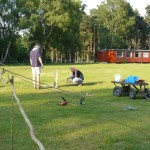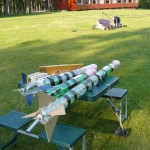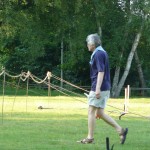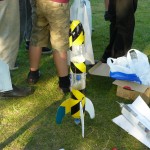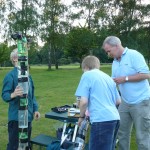Archive for the ‘Launch Reports’ Category
Some pictures from the competition
Sunday, July 6th, 2008Video from the competition
Sunday, July 6th, 2008I know its been a long time since the competition but I have been busy with so many things, I haven’t had a chance to update the site. I should now have a couple of weeks free to start working on the rockets again. First task I have set myself is to start uploading some of the pictures and videos from the competition last month.
Below is the video of Louie taking off and then veering to the right and heading into a load of trees.
I was quite disappointed that it didn’t launch straight, I intend to do some slow motion replay to try and work out what happened.
If anybody has any ideas why it did that, please let me know.
The competiton
Tuesday, June 10th, 2008I am proud to say that the hard work me and my scouts have put in over the last few months paid off, as we took home the trophy for the water rocket competition. Overall the competition was a great success with 6 teams entering and lasting for just under 2 hours. All the scout groups who took part thoroughly enjoyed themselves and we are looking to repeat next year.
Despite winning the competition, I wasn’t happy with the performance from the rockets. Below is a brief summary of the launches.
Louie
Louie, the large 4 bottle rocket struggled to accelerate up to speed and when it did, it veered off to the right, into a tree. The second launch was more vertical but didn’t achieve near the height I was hoping for and the parachute failed to deploy, badly damaging the parachute module on impact. I believe the parachute failed to deploy in this instance due to the string holding the door getting tangled, although the impact shock it so much I can’t be sure. Louie was retired after this, as we needed to try and get a good air time record.
On post calculations after the competition, I believe the cause of Louie’s poor performance to be due to low launch pressure. Louie weighs around 600g and was filled with bout 1600-1800ml’s of water. When I put those numbers into a simulator, at 70 psi the rocket would have struggled to have got off the launcher. The first launch was done at 80 psi and second at 90 psi. Its quite clear to see that the first launch had only marginally more pressure than what was needed to lift the rocket a couple of feet.
Doing some more calculations, 120psi would have gone over 300ft and 130psi was starting to near 400ft. Before this I had given up on 4 bottle rockets thinking the size of the nozzle we use are two small. But on reflection if we can get enough pressure in them, I think they should perform very well.
Huey
Huey was used for the third air time record, its first flight ended in disaster as the rocket powered up to a record height and then proceeded to fall with no parachute. I think the parachute may have not opened due to the angle of the light sensors. When the last two circuits were made, they had longer wires on the light sensors meaning that they pressed against the inside wall of the bottle, making them point more vertically. With the low position of the sun in the sky at launch I think it may have caused the circuit to be unable to determine the orientation of the rocket. Anyway the parachute module was destroyed on impact.
The last two flights for Huey were for egg recovery’s. For the first flight I had managed to repair the parachute module from Louie and to my delight it worked, safely bringing the egg back to the ground. However as I pressed the reset button on the parachute module for the next launch, a wire came unsoldered, rendering the module useless. I launched again with no parachute but to no surprise the egg was destroyed. As a comical finish the rocket then got chewed up by a dog shortly after crash landing.
Dewey
Dewey was the only rocket that consitantly performed. As the horizontal rocket it acheived the top 3 distances every time.
I hope to post some further anaylsis over the next few weeks after I have watched some of the video footage. As well as some videos and pictures and some ideas for what can be improved on for next year.
3rd WestonWocket flight and 1st Crash
Friday, May 9th, 2008I took WestonWocket out for another flight with the scouts tonight. First flight was pretty much the same as the 2nd flight last Monday. I filled the rocket about 1/3rd with water and pressurised to 75psi.
I had tightened the wing nuts on the launcher during the week and this seemed to hold the rocket much better, but a new launcher is still definitely needed.
The parachute was already packed and the trigger pin primed, a flick of the switch armed the circuit. The rocket achieved a similar height to the first launch on Monday which brings me to believe that the pressure is more important than the fill level, but further experiments will confirm this. The flight itself was went well with the parachute deploying in time. This was also the first flight I recorded a video of.
You can see that the parachute only opens once the rocket is upside down. The advantage to this over a timer is that if something goes wrong during the flight and it is shorter than anticipated the parachute will still deploy. Disadvantage as can be seen is that a lot of descent time is lost as the rocket rotates.
For the second launch the rocket was pressurised to 95psi, the rocket didn’t show any sign of leakage, so it should be good for 100psi. With the extra pressure the rocket really shot off fast and kept on going easily obtaining more than 200ft I would guess. The rocket tipped over at apogee and parachute deployed, filled with air and then opened. Then disaster struck! The rocket after a brief jolt kept on going down followed by a thud.
After running to the crash site, it was clear what had happened. The elastic bands used as a shock absorber had been stretched too far and broken. Luckily we were still flying the rocket with the sponge crumple zone nose cone, this took a lot of the impact. The only damage sustained by the rocket was fairly minimal. The cardboard housing that holds the circuit, batteries and servo had buckled and jumped over the retaining screws. Also the trigger pin was no longer attached to the servo, who knows where that is now. Apart from those small things, which should take no more than 15 minutes to repair, no other damage was sustained, however the parachute, which was left floating around 150ft up in the sky got tangled in a tree 🙁 So maybe it was luck that the rocket crashed instead of it getting caught as well???
Lessons Learnt
- Shock cord needs more elastic bands and a emergency bit of string should they break
- Rocket is probably capable of holding 100psi, although I was nervous pumping it with only 1/2 meter of hose.
- Foam nose cone helps absorb a lot of the impact during a crash.
- The battery retainer kept the batteries in the holder during the crash, worth the hassle
Actions
- Fix the rocket
- Get a longer pressure hose or extension
- Make a new parachute with a stronger shock absorber with an emergency string
First Launch Of WestonWocket
Monday, May 5th, 2008Today I performed 2 launches of the final prototype of WestonWocket, my Scout Troops first rocket.
Conditions were good, with only a slight wind on the common, although the rocket did fall over whilst attached to the launcher once during a slight gust. The launcher is a simple one taking from a kit from Maplins. I tightened the wing nuts as hard as I could, but the launcher was never meant to support such a long rocket. A new launcher will definitly need to be constructed if the rocket is to be flown in less favourable weather.
The first launch was carried out with the rocket being pressurised to only ~70 psi. Being its maiden launch, I didn’t want to risk putting any more pressure in it not knowing its structural strength. On lift off the rockets flight was pretty much vertical and turned over 180 degrees at apogee. As a rough estimate I think the rocket achieved a height of about 120-150ft, not bad for the first launch!!!
As the rocket built up speed towards the ground I started to get worried that the parachute would not deploy and open in time. Luckily the Optical Apogee sensor did its job and the parachute deployed in time and the rocket drifted down for the last 30ft.
Having confidence in the construction of the pressure vessels and knowing that the parachute mechanism worked, I proceeded for the second launch, this time with a launch pressure of 85psi. Whilst the rocket was upside down being refilled, I took the opportunity to re-arm the apogee sensor. I filled the rocket with slightly less water this time which I think was nearer to the optimum fill level.
On lift off the rocket accelerated much faster, whether this was more to do with the lower volume of water, or the extra 15psi of water I don’t know, but the rocket probably achieved near 200ft or above. Once again the apogee sensor deployed the parachute, maybe even a bit earlier this time and the rocket was gently brought back down to earth.
Due to me only bringing 2L’s of water I had to call it a day, but I am happy that the prototype flies and recovers itself.
I would like to run the rockets parameters through a simulator and try and work out what the optimum fill levelshould be and also get a more accurate idea of the height achieved.
Lessons Learnt
- The pressure vessel and Robinson couplings are capable of holding ~85psi.
- The Apogee sensor seems very reliable (well 100% success so far)
Actions
- Run rockets weight and size through a simulator to work out how much water should it be filled with and what sort of height I should expect.
